The Organ of Eglise Notre-Dame La Dalbade – Part III
PART THREE
We got to see the insides of the organ – hundreds of pipes in all different sizes crammed into a fairly small space – and we could only see about 1/3 of the pipes (there’s not a lot of space in there for visitors, and access is via a trap door and a rickety wooden ladder). There are both metal and wood pipes. The pipes can be tuned (this is not a job I would want!) by means of adjusting curls of metal on the metal pipes, or adjusting a sort of stopper thing on the wood pipes‡‡‡. Not all the pipes sound by means of air moving past appropriately shaped holes – some have a vibrating piece inside instead.
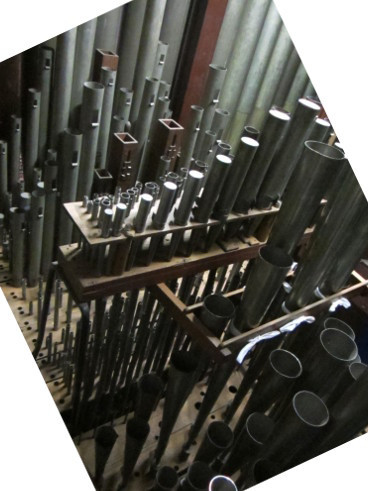
Just a few of the smaller pipes. The pipes in the foreground are about waist-high.
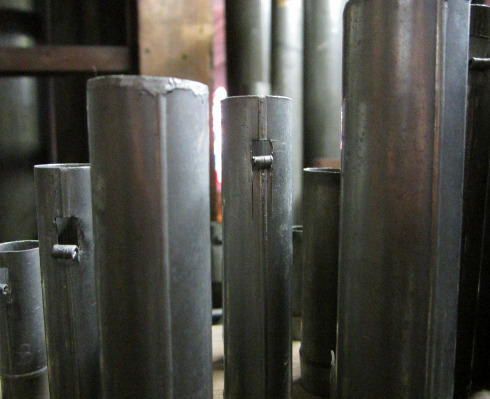
Note curls on metal pipes. These can be rolled to varying degrees to tune these pipes.
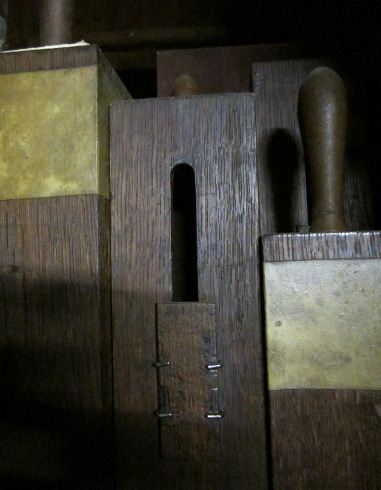
Note handle above wooden pipes and slot in side with a slidey thing inside. The stopper can be moved up and down to tune these pipes.
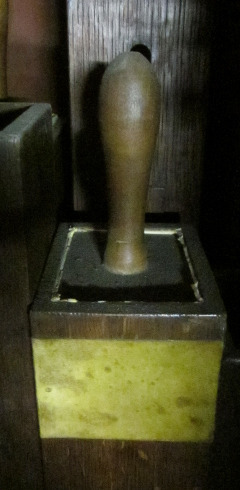
Another view of the handle/stopper tuning mechanism of wood pipes.

The vibraty bit for some of the pipes.
The organists of Toulouse rotate churches they play in on a regular basis. Mr. de Miguel was amazing to watch as he navigated the several manuals, pedal board and stops (often reaching arm-over-arm to pop a stop in or out as he kept playing with the other hand, as well as manipulating the tone color with his feet), and kept track of music with THREE staves (as a primarily string player, who only has to keep one track of one staff at a time, I found it dizzying to just follow along). There were Post-It notes on the music to help him remember what stops he wants set on this instrument, and hand-written markings all over indicating when to change the stops. We were treated to demonstrations of some of the versatility of this instrument. It can do the full-out classic organ sound one associates with Bach’s famous Toccata and Fugue… or a light, fluty sound suitable for Fauré or Debussy… a symphonic richness for orchestral rearrangements… music reminiscent of an oboe concerto… the list goes on and on.
Anybody who wanted to was also allowed the opportunity to play a little on the organ. I was surprised at how easy the action was – it felt more “solid” than a piano, and had the peculiar quality that it didn’t matter how hard I pressed the key, it didn’t affect the volume§. Each manual has the same octave range as the other two (the pedals seem to be what play the deep bass) but based on how the stops are arranged, one can get a full range of notes, from almost-inaudibly low to tooth-achingly high, as well as imitating the sounds of different instruments. I was also surprised at how quickly the sound responded. The quiet wooden shuffle-clack of the Barker mechanism behind the bench was a little distracting at first, but apparently do their job well, as the sound was almost immediate when the key was depressed. The sound was a little muted from the vantage of the bench, compared to elsewhere in the organ loft, but easily audible and it was not at all difficult to hear what I was doing (and realize when I’d made a mistake!)
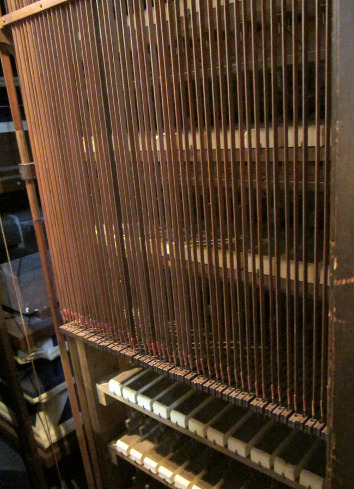
What’s easily visible of the Barker mechanism. The “wall” behind the organist is actually a sliding door which hides this. The “room” where we were with all the pipes is above and behind that.
I’m not much of a keyboardist – it’s been months since I’ve had access to a piano, and years since I’ve played much – but I made some attempts at the first third or so of Bach’s cello suite in C§§, a few lines from a Mozart piano sonata and the first section of Für Elise§§§. The organist adjusted the stops as I went – it was fascinating to hear how the different pieces sounded and changed as the stops went in and out. It was very much fun. I didn’t do much with the pedals – played a few notes just to do it, but what keyboard ability I own lives in my fingers, not in my feet.
All in all, the afternoon was wonderful. Apparently Saturday was National Organ Day, and Toulouse, being the second most organ-populated city in France, had to do something, and this is what was planned. Mr. de Miguel was very passionate about how the organ has declined in popularity, and how many instruments are unplayable (including another, almost identical Puget organ in a theater in Paris), and is hoping that publicizing and demonstrating this amazing instrument, more people will become interested in learning more about the organ.
There’s apparently going to be an organ concert at the Basilique Saint-Sernin next weekend… *
* * *
‡‡ Boyfriend thinks they said over 3000 pipes. We do know that they ranged in length from less than a foot to 32 feet in length. The stops are labelled, plus we could see them.
‡‡‡ Mr. de Miguel mentioned that they had tuned most of the pipes Friday night in preparation for Saturday – a task that took two people over six hours, and lasted til past 1am.
§ This is sort of like many unsophisticated electric keyboards – but those are “bouncy” and difficult to play in my experience. This keyboard was much more substantial.
§§ I started with that on the theory that it’s really hard to mess up a descending C major scale, followed by some broken chords before it got to the more interesting bits, and I thought I could probably mostly sound it out as I went along.
§§§ It happens that at one time, I had all of the afore-mentioned piano music memorized… about ten years ago. It was kind of embarrassing how little I could remember. I so need a piano.
* And did you GO? –editor, who has taken forever to do her job. Well, I wanted to get three guest posts out of this fabulous effort and long division [sic] is not my thing . . .
Robin McKinley's Blog
- Robin McKinley's profile
- 7221 followers



